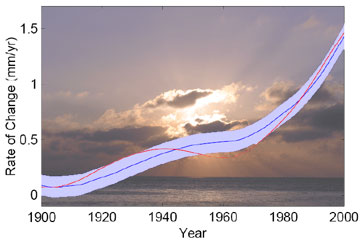Allowing the climate to rise by just two degrees Celsius—the target most industrialized nations are currently discussing in Copenhagen—may still lead to a catastrophic sea level rise of six to nine meters, according to a new study in Nature. While this rise in sea levels would take hundreds of years to fully occur, inaction this century could lock the world into this fate.
To discover how sea levels will react to ‘moderate’ warming, scientists looked to the past. Researchers turned back the clock approximately 125,000 years to the last interglacial stage when polar temperatures were likely warmer than today by 3 to 5 degrees Celsius (or 5 to 9 degrees Fahrenhiet). Since temperatures in the poles rise faster than the global average, scientists say this is approximately what they expect of polar temperatures if today’s global temperatures are allowed to reach 2 to 3 degrees above preindustrial levels.
“The last interglacial stage provides a historical analog for futures with a fairly moderate amount of warming; the high sea levels during the stage suggest that significant chunks of major ice sheets could disappear over a period of centuries in such futures,” explains lead author Robert Kopp, who conducted the work as a postdoctoral researcher in Princeton’s Department of Geosciences and Woodrow Wilson School of Public and International Affairs. “Yet if the global economy continues to depend heavily on fossil fuels, we’re on track to have significantly more warming by the end of century than occurred during the last interglacial.”
 Rate of sea level rise computed directly from the climate model simulation (red), and estimated using Eq. 1 driven by the global mean temperature from the climate simulation (blue). |
In the study researchers determined that there is 95 percent probability that during the last interglacial stage global sea level peaked at more than 6.6 meters (22 feet) above today’s present level. On the other end of the spectrum, they found that there was only a one-in-three chance that global sea level was higher than 9.4 meters (31 feet) 125,000 years ago, providing them with the range of approximately 6-9 meters.
Given that the last interglacial period was relatively recent, researchers believe it may be a good indicator of how polar sheets, and thereby sea levels, will respond to current warming. However, one of the major caveats of the study, according to the researchers, is that they are uncertain how long polar ice sheets would need to be exposed to peak temperatures in order to cause sea levels to rise to this extent.
“Despite the uncertainties inherent in such a study, these findings should send a strong message to the governments negotiating in Copenhagen that the time to avoid disastrous outcomes may run out sooner than expected.” Michael Oppenheimer said, a professor of geosciences and international affairs in Princeton’s Woodrow Wilson School.
In the US a sea level rise of 6-9 meters would permanently submerge New Orleans, most of southern Florida, and part of the East Coast. Low-lying islands—now pushing in Copenhagen for a target of 1.5 degrees Celsius—would sink meters underwater, while the ocean would come to cover most of Bangladesh and the Netherlands.
Citation: R. E. Kopp, Frederik J. Simons, J. X. Mitrovica, A. C. Maloof & M. Oppenheimer. Probabilistic assessment of sea level during the last interglacial stage. Nature, 462, 863–867, 2009, doi:10.1038/nature08686.
Related articles
Sea levels set to rise more than expected due to ‘deeply surprising’ Greenland melt
(12/14/2009) A new study by the Arctic Monitoring and Assessment Program estimates that the sea will rise by 0.5 to 1.5 meters by 2100, threatening coastal cities and flooding island nations. This is double the predicted rise estimated by the UN’s Intergovernmental Panel on climate Change (IPCC) in 2007, which did not incorporate sea level rise due to the melting of Greenland and Antarctica’s ice sheets.
US think-tank: islands affected by global warming should wait for trickle-down money
(12/09/2009) Poor island nations threatened by rising seas should wait for money through trickle-down economics, according to the founder of the US Competitive Enterprise Institute. The Washington-based free-market think tank believes that curbing greenhouse gas emissionss to combat climate change will be too costly to the US and global economies.
Bangladesh tops list of most vulnerable countries to climate change
(12/09/2009) According to the Global Climate Risk Index, Bangladesh is the most vulnerable nation to extreme weather events, which many scientists say are being exacerbated by climate change. From 1990 to 2008, Bangladesh has lost 8,241 lives on average every year due to natural disasters. In addition, rising sea levels also threaten millions of Bangladeshis.
Satellite lasers show melting of Greenland, Antarctic worse than expected
(09/23/2009) Resaerchers examining 43 million satellite measurements of Antarctica’s thinning ice sheets and 7 million of Greenland’s, show that the ice is melting faster than expected. Published in Nature the research is the most comprehensive picture to date of the melting glaciers, allowing scientists to better predict how sea levels may rise.
Sea levels set to rise as Arctic warming replaces millennia long natural cooling cycle

(09/03/2009) According to a new study published in Science the Arctic should be cooling, and in fact has been cooling for millennia. But beginning in 1900 Arctic summer temperatures began rising until the mid-1990s when the cooling trend was completely overcome. Researchers fear that this sudden up-tick in temperatures could lead to rising sea levels threatening coastal cities and islands. “Scientists have known for a while that the current period of warming was preceded by a long-term cooling trend,” said lead author Darrell Kaufman of Northern Arizona University. “But our reconstruction quantifies the cooling with greater certainty than ever before.”
Rise in sea levels due to global warming could imperil New York City
(03/16/2009) A new study shows that sea levels along the United States’ northeastern coast will rise nearly twice as fast during this century than previous predictions. By 2100 the waters around New York city could rise as much as 18 inches, leaving Manhattan particularly vulnerable to flooding from hurricanes and winter storm surges.